In this post I cover 9 Authentic and Traditional Palestinian Recipes that you can make at home, including salads, dips, baked bread, and hearty mains. I also included other Levantine recipes that are beloved by Palestinians and others alike.
There’s also a list of pantry staples and ingredients as well as important historical context that is crucial in understanding Palestinian food culture.

Table of Contents
Palestine encompasses various geographical regions, including the coastal areas like Gaza and inland regions like the West Bank. Each region has its own unique climate and soil composition, influencing the availability of certain ingredients.
For example, coastal areas might have greater access to fresh seafood, while inland regions may rely more on agricultural produce.
Historical interactions with neighboring cultures and regions have left an imprint on Palestinian cuisine. Areas near the Mediterranean may incorporate flavors influenced by Turkish and Greek, as well as Egyptian (North Africa) traditions.
Palestinian cuisine also shares similarities with other Levantine cuisines, but each region maintains its distinctive character.
Condiments and Spices
In Palestinian cuisine, spices play a crucial role in enhancing flavors and adding depth to dishes, and zaatar spice is a particularly significant and beloved spice mix. It holds cultural and historical importance, embodying the essence of Palestinian cuisine.
It’s often mixed with olive oil to create a paste that can be spread on flatbreads (Za’atar Manakish) or used as a dip. This is the way I grew up eating it. We always had 2 small bowls on the kitchen counter (one for olive oil and one for za’atar). Palestinians also use zaatar as a seasoning for meats (like in my Za’atar Chicken Thighs recipe), vegetables, and salads, adding a distinctive taste that is both aromatic and savory.
Beyond zaatar, other warm spices like ground cumin, coriander, cinnamon, black pepper, and cloves are commonly used in Palestinian food (7-Spice Mix). These spices contribute to the rich and diverse flavor profile of Palestinian dishes. They are used to season meats, rice, and stews, creating a harmonious blend of sweet, savory, and aromatic notes.
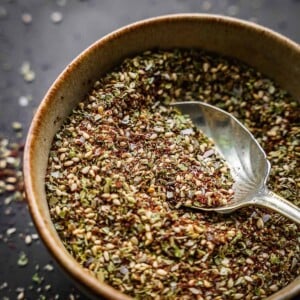
Za’atar Spice Blend
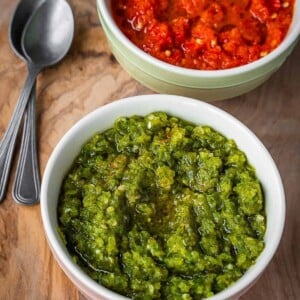
Shatta (Authentic Middle Eastern Chile Paste)
Additionally, the reliance on spices reflects the importance of agriculture and local produce in Palestinian culture, with many families growing and harvesting their own herbs and spices. This is why I am so committed to growing herbs and spices in my garden and preserving their cultural importance.
Salads and Dips
Fresh salads and dips are fundamental components of Palestinian meals, and they often feature a colorful array of fresh vegetables. Tabbouleh and Fattoush are popular across the region and on the Palestinian table. The use of fresh ingredients in salads adds texture, crispness, and a burst of natural flavors to the overall dining experience.
Palestinian culture places value on supporting local farmers and businesses. Purchasing fresh, locally grown vegetables not only ensures the authenticity of flavors but also contributes to the economic sustainability of local communities. This connection to local agriculture is deeply rooted in Palestinian culinary practices.
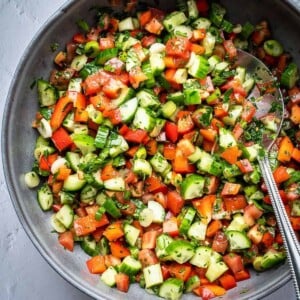
Jerusalem Salad (Cucumber Tomato Salad)

Mutabal (Authentic Middle Eastern Roasted Eggplant Dip)
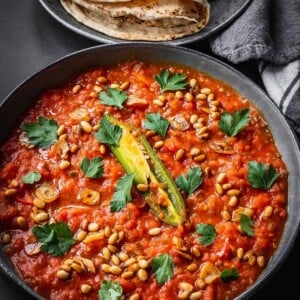
Levantine Fried Tomatoes (Galayet Bandora Recipe)
Main Dishes
Meat has cultural and social significance in Palestinian society. Meat dishes are often associated with special occasions, family gatherings, and festive events. Sharing meat-based dishes is a way of expressing hospitality and creating a sense of communal togetherness.
Meat serves as a primary source of protein in the Palestinian diet. In a region where agriculture has historically included animal husbandry, meats such as lamb, goat, and chicken are staples that provide essential proteins and nutrients. On the other hand, you will find that fish and seafood are more popular on the coast (Gaza).
Yogurt also plays a role in large mains, and takes center stage in recipes like Shish Barak, Mansaf and koussa in yogurt.
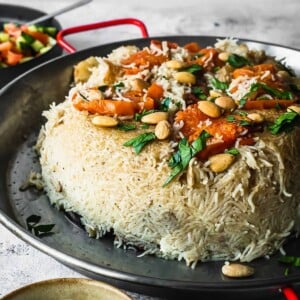
Palestinian Maqluba (Upside-Down Rice and Chicken)
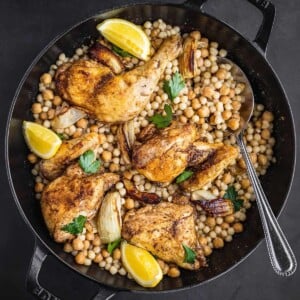
Maftoul (Palestinian Couscous)
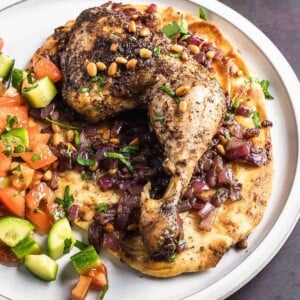
Musakhan (Palestinian Sumac Chicken with Onions)
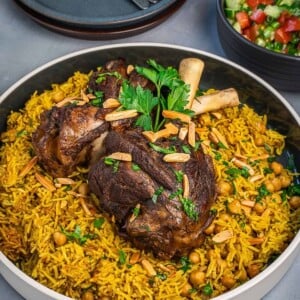
Qidreh (Palestinian Spiced Lamb and Rice Recipe)
Baked Goods and Bread
Bread serves as a primary source of sustenance for Palestinian families, constituting a significant part of their daily diet. It is a versatile food that can be enjoyed with various accompaniments, such as extra virgin olive oil, labneh (strained yogurt), hummus, and other dips.
In times of conflict and adversity, the sharing of bread becomes a symbol of resilience and resistance. It represents a commitment to sustaining life and cultural identity despite challenges. Taboon bread is of significant cultural importance.
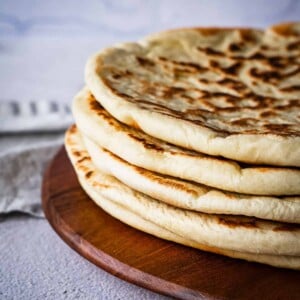
Taboon (Palestinian Flatbread)

Easy Jerusalem Bagels (Kaak Al Quds Recipe)
Important Pantry and Fridge Staples in the Palestinian Kitchen
If you haven’t cooked Levantine or Palestinian food before, you will find that you might be missing a few ingredients. Here’s a rundown of essential pantry and fridge staples.
Pantry Staples
- Olive Oil: A fundamental ingredient, often used for cooking and dressing salads, reflecting the centrality of olives in Palestinian cuisine.
- Tahini: A sesame paste that adds a rich, nutty flavor to dishes and is a key component in making traditional sauces like tahini sauce.
- Sumac: A tangy, crimson spice that imparts a unique flavor to salads, meats, and dips, enhancing the overall taste of Palestinian dishes.
- Za’atar: A spice blend of thyme, sesame seeds, and sumac, used to season bread, meats, and dips, contributing a distinctive Middle Eastern flavor.
- Freekeh: Roasted green wheat with a smoky taste, commonly used as a grain base for salads, soups, and pilafs.
- Maftoul: Palestinian couscous made from bulgur and wheat flour, often used as a base for hearty salads and stews.
- Pomegranate Molasses: A thick, tangy syrup made from reduced pomegranate juice, adding depth and sweetness to both savory and sweet dishes.
- Nuts (Almonds, Walnuts): Widely used in desserts and savory dishes, providing texture and flavor.
- Lentils: Another important pantry staple, used to make lentil soup, mujadara and other affordable recipes.
Fridge Staples
- Labneh: Strained yogurt with a thick consistency, used as a spread or dip in Palestinian cuisine.
- Feta Cheese: A versatile cheese often crumbled over salads, mixed into dishes, or served as a side.
- Fresh Cheese: Cheeses like Akkawi from the town of Akka, Nabulsi from the town of Nablus are staples. Used in savory and sweet preparations like in my Knafeh (sweet cheese pastry).
- Yogurt: A staple in various Palestinian dishes, used for marinating meats, making sauces, and as a cooling side dish. Dried yogurt, also known as Jameed is a key ingredient in the popular Jordanian-Palestinian Mansaf.
- Fresh Herbs (Parsley, Mint, Cilantro): Essential for garnishing and enhancing the flavors of many Palestinian dishes.
- Garlic: A key aromatic in Palestinian cooking, adding depth and richness to a wide range of savory dishes.
- Lemons: Used for their juice and zest in marinades, dressings, and as a flavor enhancer.
- Eggs: Versatile and commonly used in both sweet and savory Palestinian recipes.
- Tomatoes: Fresh or as tomato paste, an essential ingredient in many Palestinian stews, sauces, and salads.
- Onions: Red onions, white onions, pearl onions, green onions… all play a crucial role.
The Importance of Olives to the Palestinian Diet and Culture
Olives (and the olive tree) are culturally and economically significant to Palestinians for several reasons:
- Cultural and Historical Symbolism: Olive trees have deep cultural and historical roots in the Palestinian identity. They are often seen as a symbol of connection to the land, resilience, and continuity. Olive trees have been cultivated in the region for thousands of years, and their presence is intertwined with the history and heritage of the people.
- Economic Importance: Olive cultivation is a major component of the Palestinian agricultural sector and economy. Olives and olive oil production provide livelihoods for many farmers, contributing significantly to their income. The olive oil industry is an essential part of the Palestinian economy, and the export of olive oil is an important source of revenue.
- Land Ownership and Identity: Olive groves are a tangible manifestation of connection to the land. The cultivation of olive trees has been passed down through generations, and many families have ancestral ties to specific olive groves. The olive trees are not only a source of sustenance but also a symbol of Palestinian attachment to their homeland.
- Cultural Practices: The harvesting of olives is a communal and cultural event for Palestinians. Families and communities come together during the olive harvest season to pick the olives, share stories, and celebrate traditions. This communal aspect reinforces the sense of community and shared identity among Palestinians.
- Challenges and Symbolism of Resilience: Olive trees and the olive industry have faced various challenges, including land confiscation, destruction of olive groves, and restrictions on movement by the Israeli regime. Despite these challenges, the resilience of farmers in maintaining and protecting their olive trees has become a symbolic expression of the broader Palestinian struggle for self-determination and resistance against external pressures.
For more Urban Farm and Kitchen recipes and content, follow along on Instagram, Facebook, and Pinterest, visit the Urban Farm Shop, or subscribe for new posts via email.
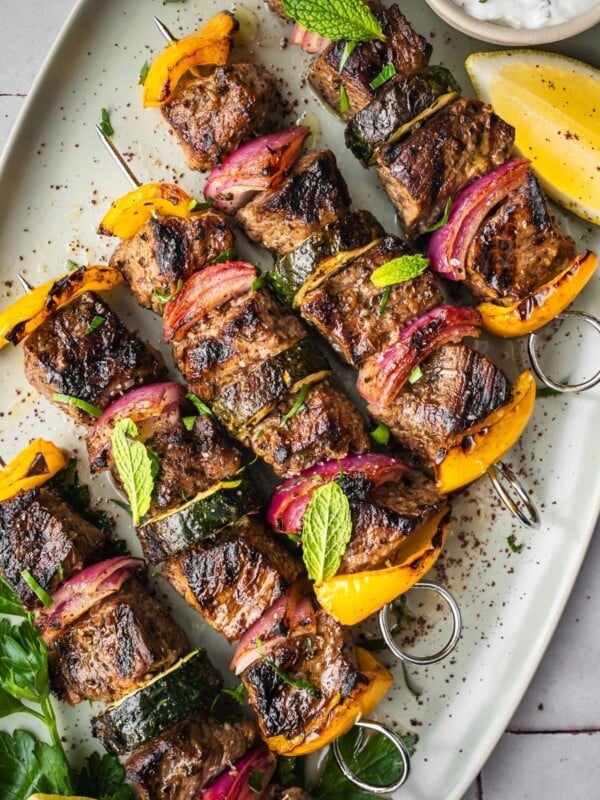

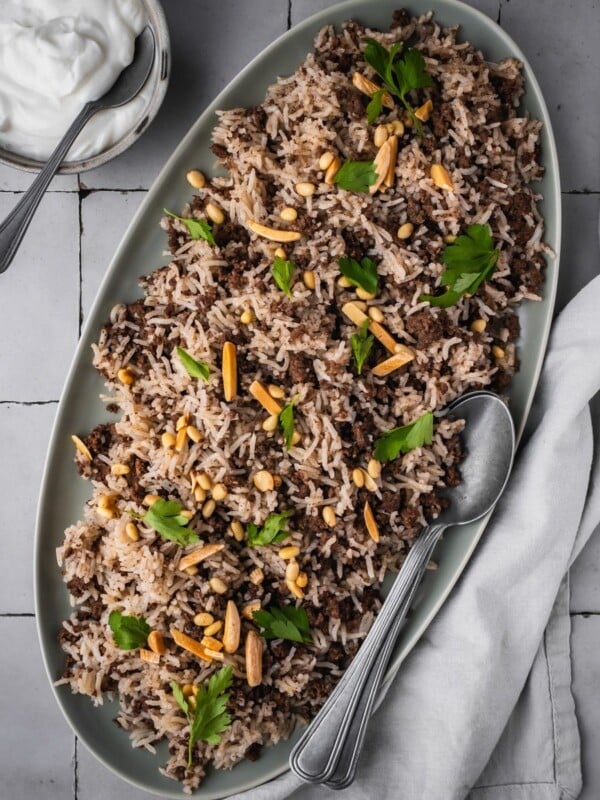
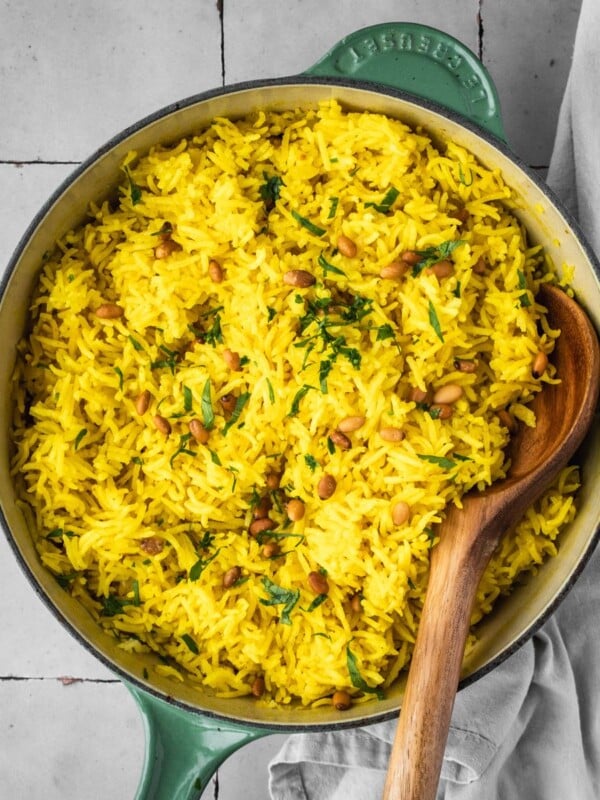








great read 🙂 can’t wait to try some!
I just found Palestinian spices in a market near me. I’m going to be cooking up a storm! I love all of the spice combinations ❤️
I’m so glad!